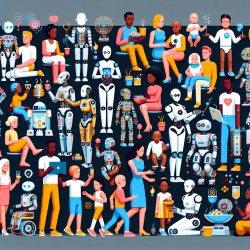Understanding Diversity in Human-Robot Interaction Research
Human-Robot Interaction (HRI) research has traditionally relied on participants from WEIRD (Western, Educated, Industrialized, Rich, and Democratic) populations. This trend raises concerns about the generalizability of findings and highlights the need for diversity in research samples. The systematic review conducted by Seaborn, Barbareschi, and Chandra (2023) sheds light on the extent of WEIRD sampling in HRI and explores additional diversity factors that may be overlooked.
Key Findings from the Review
The review analyzed 827 studies from 749 papers presented at the ACM/IEEE International Conference on Human-Robot Interaction between 2006 and 2022. The findings confirmed that HRI research predominantly involves participants from WEIRD populations. This pattern raises concerns about the representativeness of the research and its applicability to diverse global populations.
Beyond the WEIRD framework, the review identified limited representation in terms of sex and gender, race and ethnicity, age, sexuality and family configuration, disability, body type, ideology, and domain expertise. These factors are crucial for understanding the full spectrum of human diversity and ensuring that HRI research is inclusive and relevant to all.
Implications for Practitioners
Practitioners in the field of HRI can take several steps to improve the diversity of their research samples:
- Expand Recruitment Efforts: Actively seek participants from underrepresented groups, including non-WEIRD populations, to ensure a more comprehensive understanding of human-robot interactions.
- Consider Intersectionality: Recognize the complex interplay of multiple social identities and how they influence individuals' experiences with robots. This approach can help identify unique challenges and opportunities for different groups.
- Enhance Reporting Practices: Provide detailed demographic information about research participants to improve transparency and facilitate comparisons across studies.
- Collaborate Across Disciplines: Work with researchers from diverse backgrounds and fields to incorporate different perspectives and expertise into HRI research.
Encouraging Further Research
The findings of this review underscore the need for ongoing research into diversity in HRI. Researchers are encouraged to explore the following areas:
- Developing Inclusive Methodologies: Design research methods that accommodate diverse participants, including those with disabilities, different cultural backgrounds, and varying levels of technological expertise.
- Examining Understudied Populations: Conduct studies focusing on populations that have been historically underrepresented in HRI research, such as older adults, individuals with disabilities, and non-Western communities.
- Investigating Intersectional Experiences: Explore how intersecting social identities, such as race, gender, and disability, influence individuals' interactions with robots and the implications for design and deployment.
By addressing these areas, researchers can contribute to a more inclusive and equitable field of HRI, ultimately leading to technologies that better serve diverse populations.
To read the original research paper, please follow this link: Not Only WEIRD but “Uncanny”? A Systematic Review of Diversity in Human–Robot Interaction Research.










